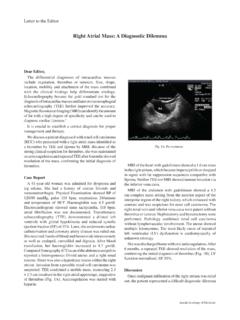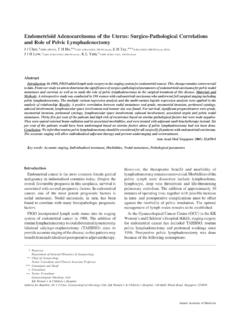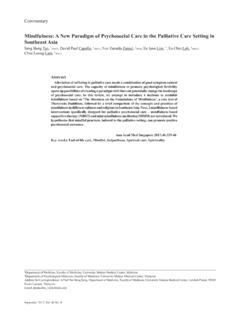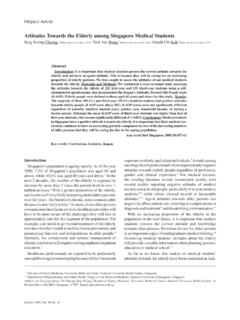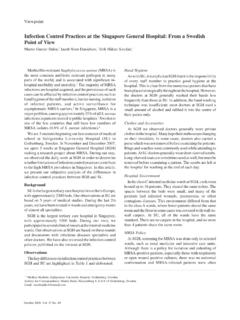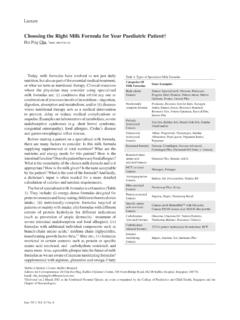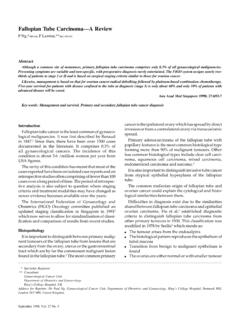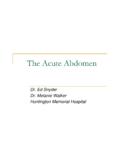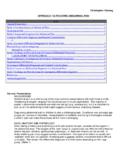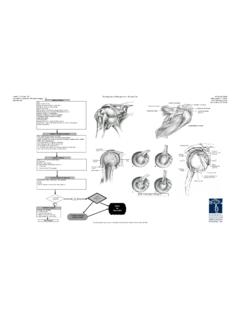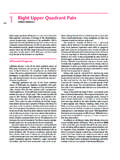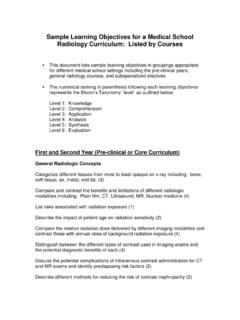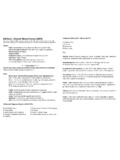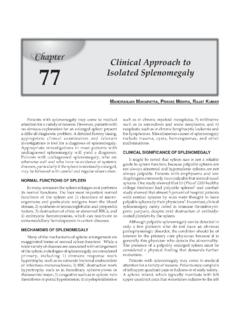Transcription of Cognitive Aspect of Diagnostic Errors
1 January 2013, Vol. 42 No. 133 Cognitive Aspect of Diagnostic ErrorsDong Haur Phua, 1 FAMS, FCEM, MRCS (Edin), Nigel CK Tan, 2 FAMS, FRCP (Edin)1 Emergency Department, Tan Tock Seng Hospital, Singapore2 Department of Neurology, National Neuroscience Institute, SingaporeAddress for Correspondence: Dr Phua Dong Haur, Emergency Department, Tan Tock Seng Hospital, 11 Jalan Tan Tock Seng, Singapore 308433. Email: Errors can result in tangible harm to patients. Despite our advances in medicine, the mental processes required to make a diagnosis exhibits shortcomings, causing Diagnostic Errors . Cognitive factors are found to be an important cause of Diagnostic Errors . With new understanding from psychology and social sciences, clinical medicine is now beginning to appreciate that our clinical reasoning can take the form of analytical reasoning or heuristics.
2 Different factors like Cognitive biases and affective infl uences can also impel unwary clinicians to make Diagnostic Errors . Various strategies have been proposed to reduce the effect of Cognitive biases and affective infl uences when clinicians make diagnoses; however evidence for the effi cacy of these methods is still sparse. This paper aims to introduce the reader to the Cognitive Aspect of Diagnostic Errors , in the hope that clinicians can use this knowledge to improve Diagnostic accuracy and patient : Affective infl uence, Analytical, Diagnostic Errors , Heuristics, Refl ective practice Ann Acad Med Singapore 2013;42:33-41 IntroductionIt was an unusually busy ward round. The newly promoted registrar was keen to review the patients handed over to him.
3 But there were constant distractions from the other things he needed to attend to patient, Madam Sumar was referred by her family doctor for chest pain with shortness of breath; ischaemic chest pain was his concern. The junior doctor who saw her planned for investigation of possible ischaemic heart disease. The young registrar reviewed her, and concurred with his colleague s assessment. But Madam Sumar was unhappy with her assigned ward and complained repeatedly; she also had other vague complaints such as giddiness and pain in her leg. The registrar wanted to move on to his next duty. Four hours later, Madam Sumar was dead from pulmonary embolism. This case was based on a real patient. The registrar had made a Diagnostic error, resulting in a preventable death. But other culprits were also in play, namely, Diagnostic momentum, availability, anchoring and under-adjustment, overconfidence, environmental stress, and counter-transference.
4 What are these other culprits? Diagnostic Errors occur when the diagnosis is unintentionally delayed (sufficient information was available earlier), wrong (another diagnosis was made before the correct one) or missed (no diagnosis ever made) as judged from the eventual appreciation of more defi nitive Cognitive factors are the most common cause of Diagnostic Errors in internal medicine1 and emergency rate of Diagnostic Errors have been estimated to be between to 12%.3 Some estimates are as high as 15%.4 The rate of negative outcome or adverse effects of Diagnostic Errors range from to 17%.3,5 A longitudinal study of autopsies in unselected patients in Switzerland suggests that the absolute rate of Diagnostic Errors may be decreasing over However, in a study of autopsy fi ndings in Cognitive Aspect of Diagnostic Errors Dong Haur Phua and Nigel CK TanReview Article34 Annals Academy of Medicine malignant neoplasms, the rate of clinical misdiagnosis in 1998 was found to have changed little compared to earlier studies in 1923 and A review concluded that the spectrum of diseases that are prone to Diagnostic Errors (namely pulmonary embolism, acute myocardial infarction, malignancy and infection)
5 Has not changed over the years, suggesting that Diagnostic Errors result from inherent diffi culties in diagnosing these conditions and are not affected by improvement in technologies or do not have local data on the rate of Diagnostic Errors nor do we know what percentage of patient adverse outcomes arise from Diagnostic Errors . Nevertheless, we can probably concur with authors who view Diagnostic Errors as being one of the more consequential types of medical Errors ,8-10 as it often leads to wrong investigations and physical sciences, clinical medicine has been described as an ill structured fi eld of When trying to make diagnoses, clinicians often face dynamic situations with evolving information. There is uncertainty as to when the search for information can be terminated; approaches used in previous similar scenarios may not be applicable in the current situation.
6 Others have described making clinical diagnosis as a wicked problem .11 Clinicians have to reframe patient symptoms into clinical problems and these problems may not be unambiguously true or false. Available solutions may only be partial and any action taken by the clinician can alter the situation in signifi cant and irreversible ways, to the extent that the problem itself may be , the goals of management can be incomplete, vague, mutable, or at times, contradictory. In many situations, there is no immediate or ultimate test to tell the clinician if he or she is right. Immediate feedback is often unavailable to clinicians; the diagnosis may be delayed or hidden, or the problem may change without any action being taken. These limitations restrict the ability of clinicians to re-calibrate themselves. In many instances, the diagnosis and decisions are not only dependent on the clinician s thinking but are conjoint Cognitive outcomes of the clinician, the patient, patient s kin and the prevailing The diagnosis may also have arisen over a period of time like over several consultations instead of a single point in ,13 How Clinicians Make DiagnosesThe normative model for making clinical diagnoses is Bayes theorem,14 where doctors use pieces of information regarding the prevalence of various clinical features in different disease entities to calculate the probability that a particular disease is present.
7 However, this method is impractical in actual clinical practice due to the complexity of the calculations; and much of the required information may be How then do clinicians actually make diagnoses? Investigators believe that it is impossible for any clinician to search for or consider all information or evaluate all possible hypotheses, hence the search for the correct clinical diagnosis is typically limited to satisfactory solutions within the constraints of the clinical Most authors accept that the dual process model of reasoning explains how clinicians make It appears that we make choices using 1 of the 2 systems of thinking. System 1 is intuitive, automatic and requires little Cognitive capacity. System 2 is refl ective, analytical and requires Cognitive 2 which is analogous to the hypothetical-deductive or analytical method is often taught to medical students.
8 The process consists of fi rst taking a history from the patient, and using a key fi nding to generate a list of differential diagnoses. Further information gathered is then used to pare down the list of differential diagnoses until only 1 or 2 are left. Much time is then invested to obtain information to confi rm the fi nal list of differential diagnoses is generated relatively early during consultation (mean duration 28 seconds into consultation); the fi nal diagnosis is derived at between 1 and 7 The earlier the diagnosis is arrived at, the more likely the diagnosis will be correct; this may be due to the diagnosis being an easy one to make. The initial list of differential diagnoses is limited by our short-term memory and consists of no more than 2 to 6 choices. If this initial list does not have the correct diagnoses, the chance of fi nally arriving at the correct diagnosis appears to be slim.
9 This process of making diagnosis is energy intensive, relies on working memory and appear to localise to the right inferior prefrontal In contrast, System 1 is described as the heuristic or pattern recognition method of making diagnoses; it is often used by experienced clinicians. System 1 is developed through clinical experience;20 these accumulated experiences are stored in the memory of clinicians as illness scripts,21 which can be represented as a past example or as an abstract Upon encountering a case, a clinician will match the pattern of the case to his stored illness scripts and arrive at a diagnosis. This mode of making diagnoses imposes less Cognitive load, and is relatively fast and effi cient when compared to System 2. Clinicians are shown to match the right diagnoses within 10 seconds of The process appears to localise to the ventral medial prefrontal cortex (Table 1).
10 19 Medical students and clinicians start their career using System 2 to make diagnoses. With experience, they Cognitive Aspect of Diagnostic Errors Dong Haur Phua and Nigel CK TanJanuary 2013, Vol. 42 No. 135accumulate illness scripts; this allows them to transition to more System 1 reasoning. However, when they encounter a novel clinical scenario that is not represented by their stored illness scripts they may revert to System 2 ,21 An expert clinician is believed to have a large store of illness System 1 mode of making diagnoses is heavily reliant on past experiences and intuition; it is usually recognised as a component of clinical Both systems can interact and/or override each other, and repeated use of System 2 can lead to formation of illness scripts that are eventually used in System 1 (Figs. 1 and 2).
